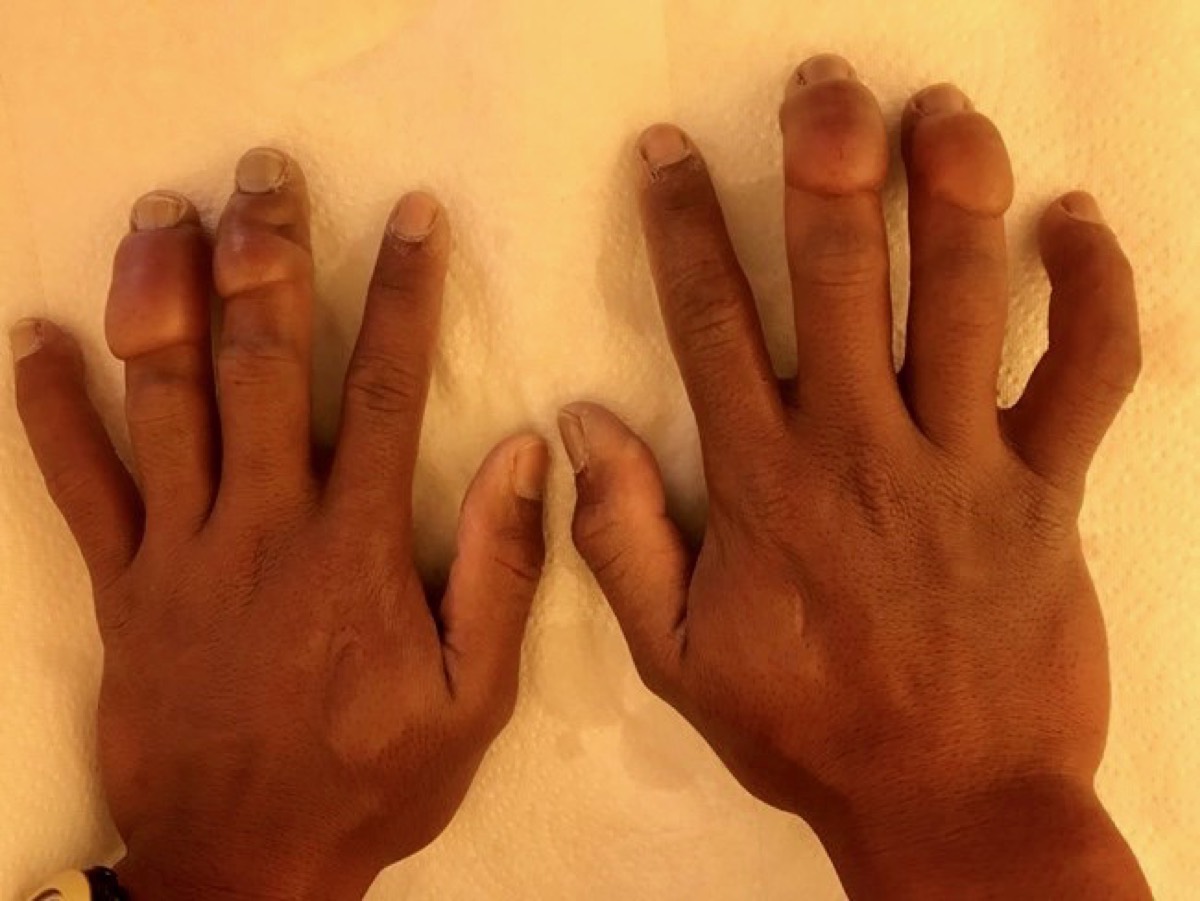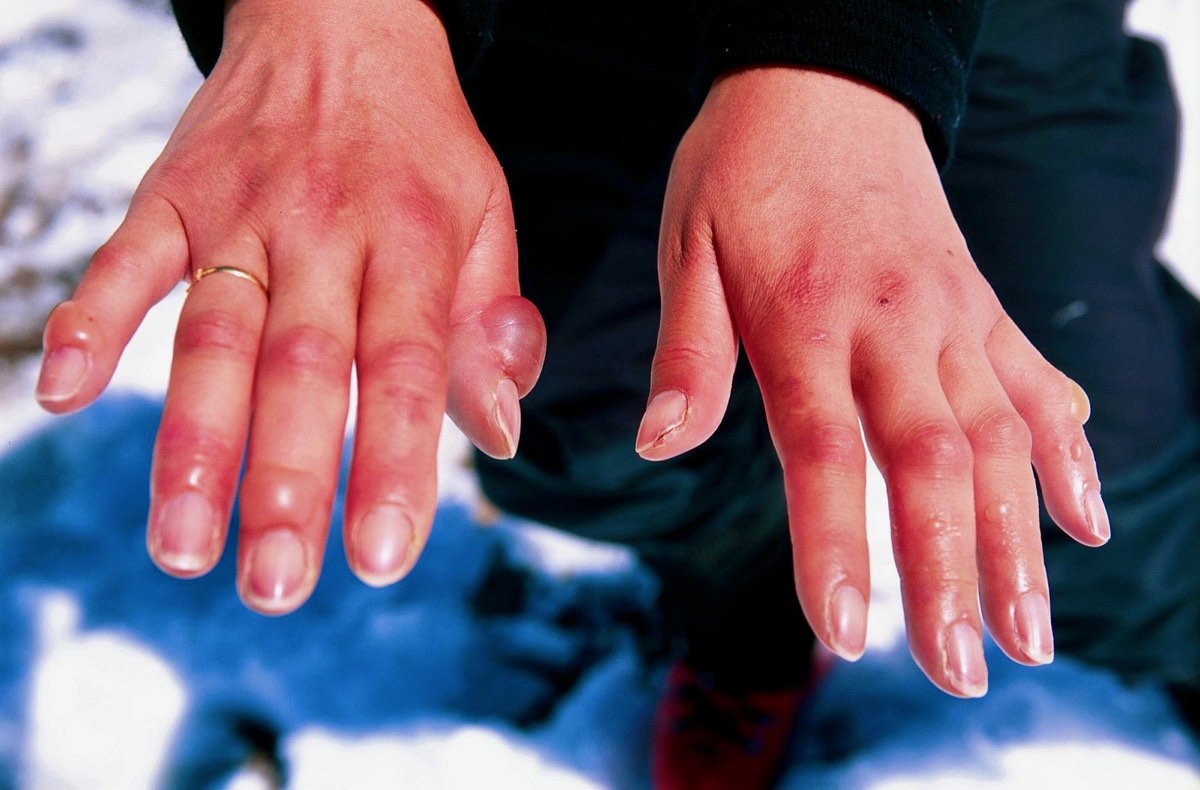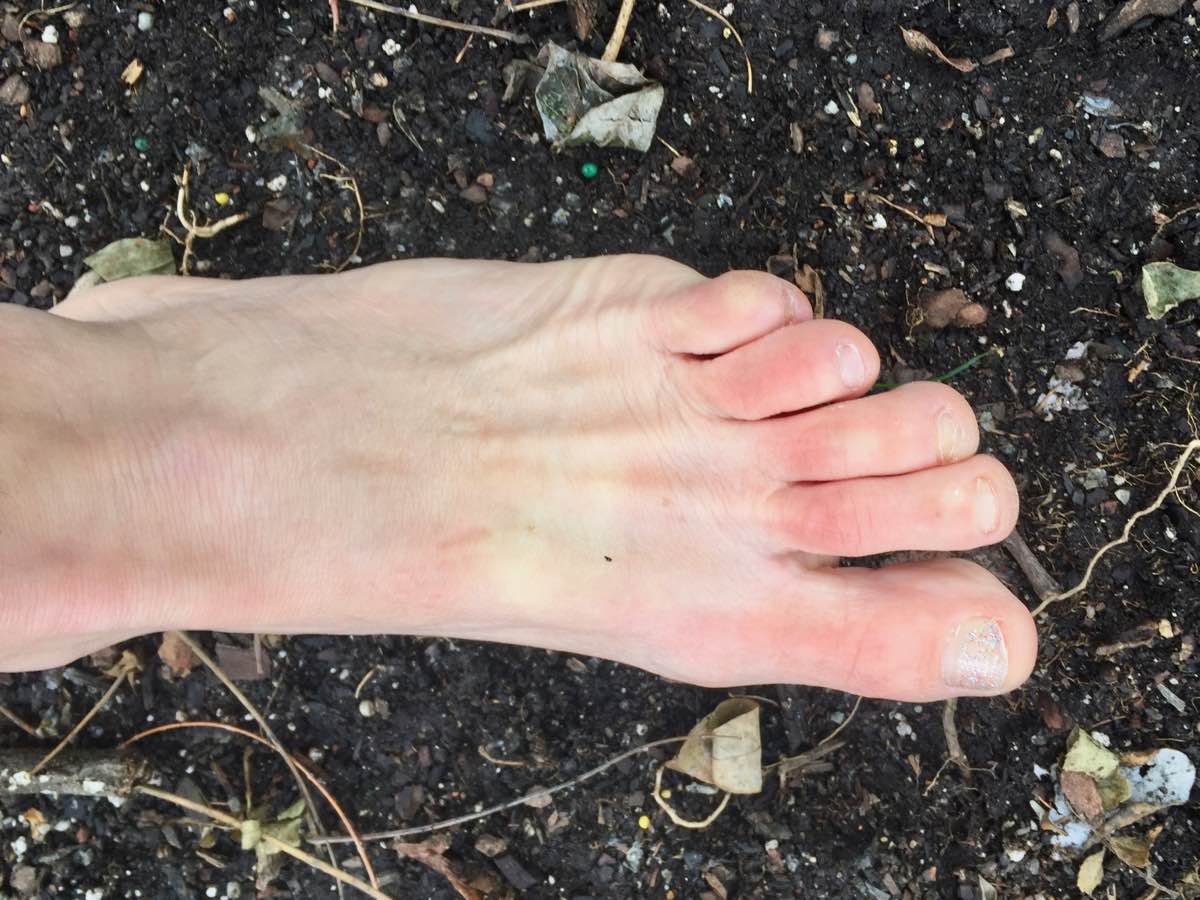[Editor’s Note: The following article contains two photos of the ‘normal’ blistering of hands that occurs after frostbite. Be aware that they might be a bit uncomfortable to look at.]
Scenario 1:
You and your running buddy are out for your first long run of the new year. It’s only 27 degrees Fahrenheit, but you’re feeling comfortable. Maybe you’re warm because you’re so fired up about all the races you signed up for in 2019, or maybe it’s the leftover cookies and eggnog latte you had for breakfast. Regardless, you’re not cold and you’re having a great run. You stop to go to the bathroom and when you get back to the trail, you find your friend struggling to open a gel. She can’t seem to get a good grip on it to rip it open. She takes her gloves off to try. No dice. She says, “My fingers are freezing!” Finally, she puts the gel between her palms and opens it with her teeth.
What should you do?
A. Holler: “Don’t tolerate numbness!” And tell your friend to put her ungloved hands on the skin under her armpits.
B. Holler: “Don’t tolerate numbness!” And tell your friend to do arm circles.
C. Holler: “Don’t tolerate numbness!” And tell your friend to put her hands on your bare belly.
D. All of the above.
Choose an answer before continuing.
Answer: D. All of the above.
“Don’t tolerate numbness!” is an important mantra in cold weather. It’s the third-most-important mantra after: “Don’t eat yellow snow.” and “Don’t accept triple dog dares involving flag poles.” Sure, you don’t have to holler it at anybody, but it’s important enough that you could.

Image: Semi-Rad/Brendan Leonard
Numbness and tingling means the blood vessels in your friend’s fingers are constricted and there’s less warm blood flowing to them. If her fingers stay cold like this, without warm blood, they’re likely to freeze. Ice crystals will form in and/or around the cells in her fingers. And this often means permanent damage. So numbness and tingling in the fingers, toes, ears, nose, or cheeks is a red flag to stop and take action. Numbness, unlike pain, is easy to ignore. But the consequences for ignoring it are great. Don’t tolerate numbness!
In this scenario, any of the rewarming options would work. The skin on your torso is well over 90 degrees Fahrenheit. If your friend puts her bare fingers on her belly or in her armpits, they’ll rewarm nicely. Of course, this skin-to-skin rewarming isn’t fun. Who wants to put ice-cold fingers on their belly? It’s also a bit of hassle taking off your gloves and shoving your hands under your clothes to get to your armpits. If you’re with someone who’s not taking care of themselves, try to get them to do big arm circles to move blood back down to their fingers. If they don’t do a good job and their fingers stay numb, offer your warm belly to them. Having someone put their ice-cold hands on your warm belly is awful, but it will prevent them from getting frostbite–and will also guarantee your entry into heaven.
The scenario continues: You don’t think your friend’s cold fingers are a big deal. You figure her hands will warm up once she starts running again. Your hands aren’t cold, so how bad could hers be? You run for another two hours. When you get back to the car, your friend asks you to get her keys from her pack. “My hands aren’t working so well,” she says. She holds them up for you to see. They look like this:
How can you tell whether your friend has frostbite or just very cold hands?
Answer: Touch them.
You can’t rely on skin color to tell you whether you’re looking at a freezing or non-freezing cold injury. Frozen fingers are no longer soft. The skin might feel stiff. The more deeply frozen the skin is, the less pliable it is.
Your friend’s fingers feel like chicken tenders that have been in the freezer for an hour.
What should you do?
A. Rub her hands vigorously until they feel warm.
B. Tell her to blow on her hands to warm them up.
C. Give her a hand warmer to hold.
D. Call an ambulance.
E. None of the above.
Choose an answer before continuing.
Answer: E. None of the above.
There are ice crystals in your friend’s fingers. You need to melt that ice rapidly. Ideally, you’d submerge her hands in water warmed to 99 to 104 degrees Fahrenheit. (This is about the temperature of a hot tub.) That will reheat them evenly and quickly. Since you don’t have the means to heat water or measure its temperature in your car, your friend should just use her body heat to rewarm her fingers. Belly, armpit, and thigh skin are great 90-plus-degree heaters.
Don’t use friction to rewarm her hands. The jagged edges of the ice crystals in her fingers will cause more damage if they’re moved back and forth against one another. And blowing on fingers will make them more moist than warm. Wetter fingers are colder fingers. Hand warmers can also be problematic for numb fingers. The reheating is uneven, and your friend wouldn’t be able to tell if the hand warmer is too hot, and she might actually get burned.
You don’t need to call an ambulance, but if the frozen area is bigger than the size of a quarter, your friend should get it checked out by a medical professional.
The scenario continues: As your friend’s fingers warm, she starts to swear. “Oh my gosh! *$!**$#!!! That hurts! Shoot, they’re burning! DANG!” Frozen fingers, toes, ears, and more really hurt as they rewarm. This is not dangerous or a reason to stop rewarming though. It is a natural part of the rewarming process, so expect the pain and try to work through it.
Your friend doesn’t want to get checked out. You drop her at home, but later that night, she texts the following picture of her hands:
If just the top layer of skin is involved, we often call the frostbite ‘frostnip.’ But blisters like these mean both the top layer of skin, the epidermis, and the layer underneath, the dermis, has been frozen. If the freezing had gone deep into the dermis, the blisters can be filled with blood. Here’s another example of blisters from frostbite:
Blisters can take 12 to 36 hours to form. You need to get the injury checked out by a professional. Infection is difficult to prevent with blistering. Do not drain the blister fluid! And take that ring off too. The fingers will continue to swell and it could become a tourniquet.
The scenario ends: At the hospital, they clean your friend’s hands, wrap the fingers in gauze, prescribe a pain medication, and tell her to watch carefully for signs of infection. In time the fingers heal, but your friend has problems with sensation in her pinky and ring finger for the rest of her life due to nerve damage.
Scenario 2:
It’s 33 degrees Fahrenheit, gray, and drizzling. You’re working an aid station at a 100-mile race. The new gear you got for the holidays is keeping you warm and toasty. You’ve got hand warmers tucked between your socks and your leggings, so your feet are nice and toasty too. It’s about nine hours into the race when a particularly miserable looking runner comes in. His shoes and socks are covered in mud. He asks for his drop bag, and walks over to a chair. You bring him the bag and ask how you can help.
“Could you get me a new pair of running socks? My feet feel like blocks of wood. I can’t feel my toes.”
He pulls off his wet socks and his feet look like this:
Is this frostbite?
Answer: You can’t tell by looking. Remember, you can’t rely on skin color to tell you how bad things are. You have to touch the skin to tell if it’s frozen or not.
His toes are very cold, but the skin is still soft. You’re just looking at a very cold foot. But, again, the numbness means the blood vessels are constricted, and there’s not much blood moving around the toes. You need to fix that so his toes don’t freeze. But you also need to warm his toes because constricted blood vessels also don’t deliver much oxygen. And even if the tissue doesn’t freeze, this lack of oxygen can cause permanent damage if it lasts for hours. Chronic pain and lack of sensation are common with non-freezing cold injuries.
What should you do to help this runner?
A. Holler: “Don’t tolerate numbness!” And help him put on his dry socks and more layers.
B. Holler: “Don’t tolerate numbness!” And ask him to do toe crunches.
C. Holler: “Don’t tolerate numbness!” And have him stand up and do leg swings.
D. Holler: “Don’t tolerate numbness!” And help prop his feet up in front of the aid-station fire.
Choose an answer before continuing.
Answer: A. Holler: “Don’t tolerate numbness!” And help him put on his dry socks and more layers.
Dry socks alone won’t rewarm his feet, but wet socks are going to keep them cold, so help him put dry socks on. Put a garbage bag over his feet and rest them on his shoes. The bag will trap heat and protect his feet from any wind, and the shoes will insulate his feet from the ground. Don’t put his wet shoes back on until the numbness is gone.
See if he has any more clothes in his drop bag and help him put on more layers. Put a blanket over his shoulders, and put a hat on his head. The warmer his body is, the warmer his feet will become. If he’s chilly, the blood vessels in his feet will probably stay constricted and his feet will stay cold. Finally, give him some hot chocolate, so he has enough calories to keep himself warm.
Scrunching your toes and working the muscles in your feet are unlikely to rewarm numb toes. There’s just not enough muscle tissue in the feet to generate heat. Big leg swings are effective at forcing blood back down into the feet, but it’s hard to do good leg swings after you’ve been running for nine hours. And never put numb feet up to a fire. It’s too easy for someone to end up with burns because they can’t tell when their skin is getting too hot.
The scenario ends: The runner is taken aback by your hollering, but he also feels a lot less miserable with the extra layers, blanket, and hot chocolate. The pins-and-needles sensation as his toes rewarm is intense. He swears a bit to himself. Eventually, the discomfort subsides, and he tells you he wants to finish the race. He has socks in each of his drop bags and a new pair of shoes in one too. He’ll change into the socks and shoes as he comes to them to keep his feet as warm and dry as possible. You tell him to make sure to take off the extra layers if he starts to sweat so he doesn’t get chilled and give him one more cup of hot chocolate with a dollop of peanut butter mixed in for a few more heat-generating calories. He finishes the race, goes on to get a Drymax sock sponsorship, and never forgets your counsel: “Don’t tolerate numbness!”
Prevention
We all know the basics about dressing for the cold. I’m interested in the strategies you use to keep your hands and feet warm when you’re running in cold weather and snow. Here are a few ideas from some runners to prime the pump. Some of the tactics are good general principles and some are individual in their effectiveness. All are good tools for your toolbox. Please share your ideas!
- Runner A always carries one extra layer for their feet and hands on winter long runs.
- Runner B wears mittens to keep her fingers warm, “There is a night-and-day difference between wearing gloves and mittens for me. No matter how thick the gloves, my fingers stay cold. Two minutes after switching to mittens, my hands are nice and warm.”
- Runner C swears by wearing plastic bags on her feet for runs in the winter where it’s pretty cold and her feet are going to get wet because of running through snow or slush. The plastic bags are primarily intended to help hold in the heat generated by your feet, not to keep your feet dry.
- Runner D doesn’t wear membraned shoes in cold, wet weather because it traps water in the shoe and against his skin.
- For very, very cold temperatures, Runner E uses hand and foot warmers.
- Runner F says that in winter they anticipate when they might get cold and add layers before they actually begin to feel cold. “Climbing up to higher altitudes and about to leave the trees? I put on an extra layer over my hands before continuing. Did a big uphill in cold weather and now I’m heading down where I’ll generate less heat? I put an extra layer on my hands before I head down. It’s getting dark and I still have some distance to run and I know it’ll get colder soon? I add layers in anticipation of the cold.”
- Runner G says: “When my toes get cold while running, I’ll crunch my toes each time my foot is lifted off the ground.”
[Author’s Note: Learn more about caring for frostbite and non-freezing cold injuries and other wilderness first-aid skills with a two-day NOLS course. Thank you to Tod Schimelpfenig, NOLS Wilderness Medicine’s Curriculum Director and author of NOLS Wilderness Medicine, for his guidance and oversight of this series. Thanks also to graphic artist Brendan Leonard, the trail and ultrarunner of Semi-Rad fame, for his graphics collaboration in this article series.]
Call for Comments
- What do you do to keep your hands warm on cold runs?
- What do you do to keep your feet warm on cold runs?




